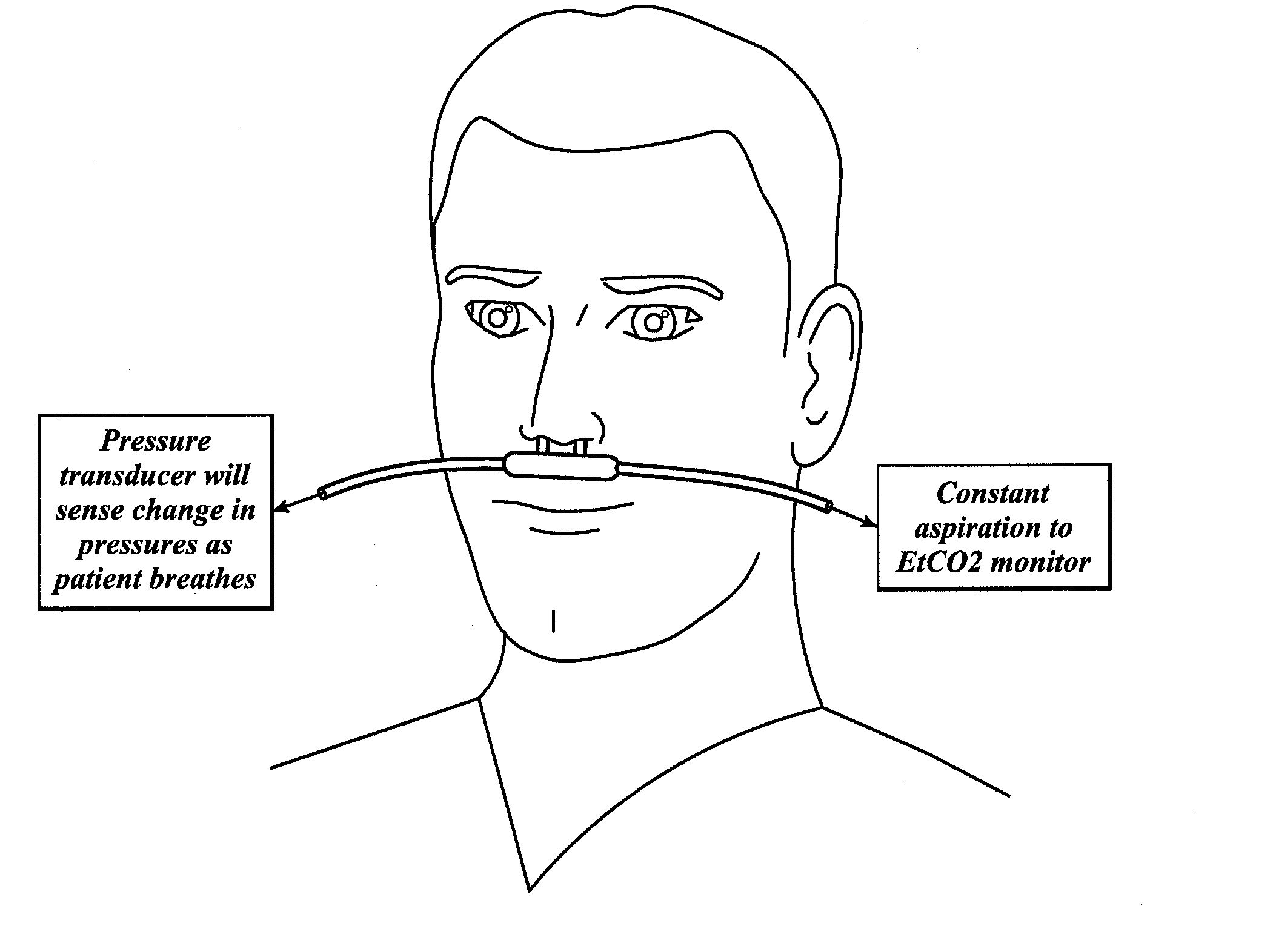[0010]The invention is a cannula capable of multiple simultaneous uses. Specifically, the design of the hollow body of the cannula allows the measurement by at least two devices measuring multiple components from the gases exhaled from both the patients nostrils and mouth and / or insufflating a treating gas. In one example, the cannula disclosed herein allows simultaneous monitoring of the patient's
respiratory airflow and delivery of a treating gas. In another example, the cannula allows simultaneous monitoring of patient respiratory
airflow and sampling of exhaled gases for analysis. Additionally, the cannula could monitor a plurality of gas variables including
carbon dioxide levels. These multiple uses are accomplished through the use of a hollow body which allows the mixing of the gases from the patient's nostrils and / or mouth to be connected and measured to multiple measuring devices. The use of the hollow body also provides more accurate measurements in certain situations.
[0012]The invention also provides more accurate results than the prior art because the hollow body of the invention is connected to at least two nasal and / or oral orifices of the patient. This allows simultaneous measurements of pressure and composition to be taken from the totality of gases exhaled by the patient instead of those gases exhaled by only one
nostril. For example, if the patient has a blocked
nostril, measurements from multiple orifices gives a more accurate reading of the gases exhaled by the patient compared to a cannula that only measures gases from one nostril. This is due to
signal attenuation. This
signal attenuation can be due to a blocked nostril or similar condition that causes an unequal flow of gases through each nostril of the patient. This is particularly a problem when the cannula being used has a separation inside the hollow body which allows measurement of exhaled gases only from one nostril. Specifically, a patient with a blocked left nostril will exhale significantly less gas through the blocked nostril than her other unblocked nostril. This will give an attenuated signal to the measuring device attached to the blocked left nostril.
[0013]This invention's accuracy over the prior art is due to the use of the hollow body. The hollow body captures the exhaled gases from both nostrils and / or the mouth. Thus, a single blocked nostril will not give a false reading as the totality of gases exhaled by the patient is captured by the hollow body from the other unblocked nostril and / or mouth. Additionally, the use of a hollow body as a common connection point to a plurality of measuring devices allows multiple signals to be recorded by all the measuring devices attached to the hollow body instead of only one device.
[0014]In addition, the invention measures pressures and simultaneously delivers treating gases better than the prior art. In the prior art such as two cannulas taped together, one nostril was used to obtain measurements and the other nostril was used to deliver
oxygen to the patient. However, the administration of a given flow of
oxygen through one nostril instead of two may have a greater
drying effect on the single nostril to which oxygen is delivered. Thus, the amount of oxygen which can be successfully delivered for a long period of time through one nostril may be substantially less than that which could be delivered through two nostrils. For example, the administration of 3 liters per minute of oxygen through one nostril will have a
drying effect on that nostril equivalent to the administration of 6 liters per minute through both nostrils. Thus, the quantity of oxygen that can be delivered to the patient is limited to the amount that can be fed through one nostril without undue crusting of nasal secretions and / or undue
drying of nasal mucosa. In the current invention, the oxygen is delivered to both nostrils which would have less of a drying effect.
[0015]Additionally, this invention helps meet the need of sleep
physiologic monitoring that uses two separate cannulas taped together at the patient's
nose to sample exhaled gases or deliver a treating gas and / or to monitor a patient's respiratory
airflow. Patients often find the use of two bulky cannulas placed in their nostrils cumbersome and sometimes this configuration even attenuates the signals of one, or both, of the individual cannulas attached to measuring devices. The use of this device enables only one set of nasal tubes to be inserted into the patient's
nose o provide simultaneous pressure readings with
gas analysis or therapeutic gas administration.
[0016]Thus, the invention allows the use of a single cannula for patient interface in order to make the patient more comfortable and provide a more accurate reading of the gases exhaled by the patient. The cannula of the present invention enables more accurate analyses and measurements of a patient's exhaled gas, minimizes patient discomfort, and enhances the delivery of treating gases.
 Login to View More
Login to View More  Login to View More
Login to View More 


